Longitude: 175 41.698W Latitude: 59 43.948N
****It may not be sunny and 75 here in the high latitudes but it is still growing season and the ocean around us is in full bloom! While it might not be as picturesque as the cherry blossoms that have blanketed the East Coast this spring, looking through the microscope the scenery is just as mesmerizing...
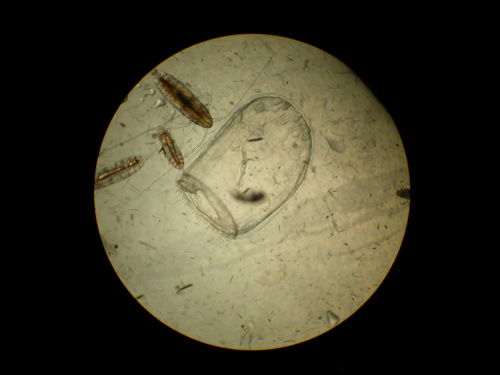 Looking through the microscope in the cold room, I peeked into a miniature world had been swimming around in the net just minutes before. What do you see? A mini jellyfish maybe?
Looking through the microscope in the cold room, I peeked into a miniature world had been swimming around in the net just minutes before. What do you see? A mini jellyfish maybe?
What is this artistic creation? It's a zooplankton wonderland! Plankton are free-floating organisms that slosh around in the world's waterways. Zooplankton are small animals and phytoplankton are the single-celled plant version. Most are microscopic but some you can even see if you look closely with your naked eye. Right now in the Bering Sea, the phytoplankton is in full "bloom". Blooming phytoplankton prompts a population surge in the zooplankton that feed on them creating lots of excitement in the Healy science labs!
What prompts the bloom you might ask? Great question! It's been a long dark winter here in and near the Arctic. No photosynthesis occurs during those months and the plankton is running on empty in survival mode. Organic matter decomposing in the water and in the deep mud is being recycled by the Earthworms of the sea, polychaetes. The Bering Sea water becomes a nutrient rich zone but there's no one coming to dinner...yet! There's many months of winter and lots of mixing to be done during this time. As the ice begins to form at the top, the plankton are thrown into a mixing bowl. Water that was divided into calm layers of oceany realms is suddenly being jumbled as the ice forms. Salt is excluded out of the water as it freezes, the layer left behind becomes heavier with this leftover salt. The top layer sinks and the layers of the water column are flipped. Yikes! Then, there's the wind. Paired with the ice, it works like a big spoon, mixing the ocean soup from the top. Tides jump in to do some mixing too! Talk about a whirlpool! Imagine taking an apartment building and turning it upside-down. The residents wouldn't be very happy. Neither are the plankton. The phytoplankton that are caught up in this vertical conveyor belt are shuffled between the light top layers and the dark benthic layers with such regularity that they can't get enough light to do much more than survive. So how is this cycle broken?
The onset of spring means a series of events are set in motion that calm the chaos and create favorable conditions for growth in the water. Longer days with more direct sunshine mean more photosynthesis can occur but this is only the beginning of the story...When the "lights" turn back on as the Sun returns in the spring, you would expect to see the plankton start to grow like crazy. Not so. The melting ice has some work to do to stop the mixing, and create a happy, home for the plankton in a stable top layer.
As the ice melts at the top of the water column, it creates a lens of water that is fresher than the layers underneath. The top layer is colder- remember it was just ice all winter. This layer hangs out at the top because although cold water is heavier than warm, fresh water is lighter than saltwater. In this case- fresh trumps cold. This newly introduced top layer soon becomes stable enough that the plankton can hang out happily there avoiding the spin cycle below. They emerge from survival mode begin photosynthesizing at a great enough rate that they can grow rather than merely survive. Levels of chlorophyll in the water then skyrocket. High chlorophyll levels show scientists that there is lots of biomass (living stuff) that is green and growing. Greens are good for everyone! The more producers there are the more, the more productive the environment is. Makes sense, huh?
So is chlorophyll the only thing that matters? No way! Other sources of nutrients in the water that are key to growth in the Bering Sea are nitrogen, phosphorous and silica. Diatoms, (microscopic algae), need silica to form their outer body-casing, Nitrogen and phosphorous are necessary for growth. Some of these ingredients come from the nutrient buffet in the benthos, some come the Pacific via from the ocean conveyor belt and some even are washed off the land.
Whew!!! Got all that? Even if you didn't... here come the pictures!
No matter who gets the good stuff or where it came from, the Bering is in bloom! Yesterday morning we were on the fantail at 5 am to reap the bounty!
Like storm-chasers tracking a killer tornado, the scientists on the Healy are following the bloom! Sampling in waters teaming with life means striking gold to the zooplankton team... it may smell more like tea and look like soup but ask Carin, Donna, Phil or Celia and they'll tell you they have struck it rich!
They sample the zooplankton a few different ways. First there's the Ring Net...
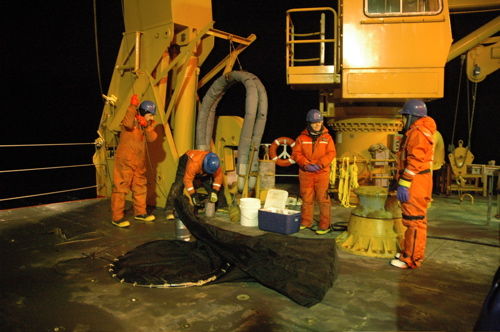 The zooplankton team convenes at 5am most mornings to deploy the Ring Net. Here they spread it on the back deck, attach the Cod End (sampling bottle) and get ready to hoist it up and over the side.
The zooplankton team convenes at 5am most mornings to deploy the Ring Net. Here they spread it on the back deck, attach the Cod End (sampling bottle) and get ready to hoist it up and over the side.
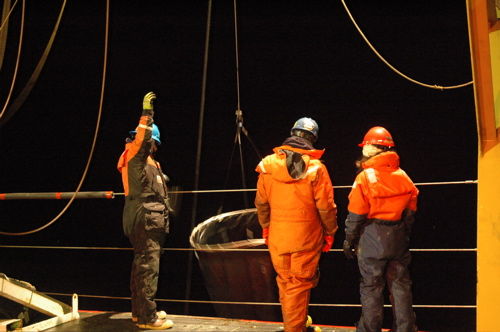 Phil Alatalo and I wait to pull in the Ring Net and see what we've got. Luckily the water was ice- free yesterday morning which meant no snow-cones in the net!
Phil Alatalo and I wait to pull in the Ring Net and see what we've got. Luckily the water was ice- free yesterday morning which meant no snow-cones in the net!
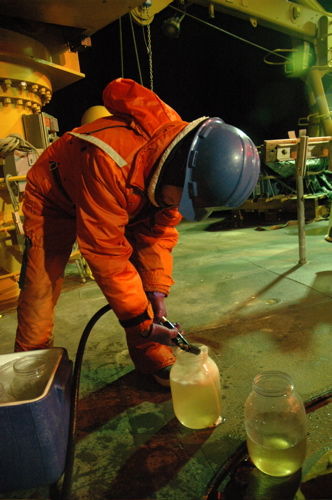 Donna Van Keuren gets ready for the sample to come on deck by preparing jars of salt water to pour the plankton into. By getting the bottles ready beforehand the plankton are less stressed after they are yanked out of the water.
Donna Van Keuren gets ready for the sample to come on deck by preparing jars of salt water to pour the plankton into. By getting the bottles ready beforehand the plankton are less stressed after they are yanked out of the water.
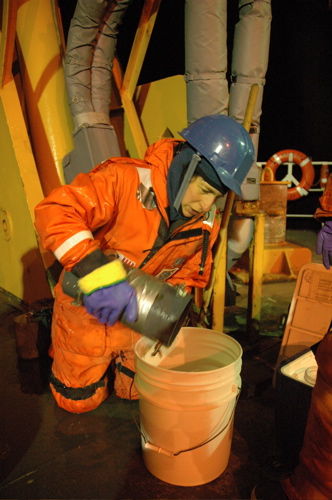 Yesterday morning there was lots of good stuff in the Cod End (the sampling bottle). Celia Gelfman, of the University of Rhode Island empties out the collection into a bucket on deck. It smelled and looked a little like iced tea!
Yesterday morning there was lots of good stuff in the Cod End (the sampling bottle). Celia Gelfman, of the University of Rhode Island empties out the collection into a bucket on deck. It smelled and looked a little like iced tea!
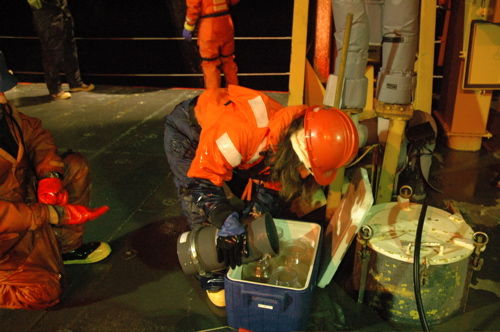 Separating the sample into different jars is easier said than done in double gloves that are all wet. I'm trying not to spill any of it! Yikes!
Separating the sample into different jars is easier said than done in double gloves that are all wet. I'm trying not to spill any of it! Yikes!
Then there's the Bongo Nets... (Why do you think they are called that?)
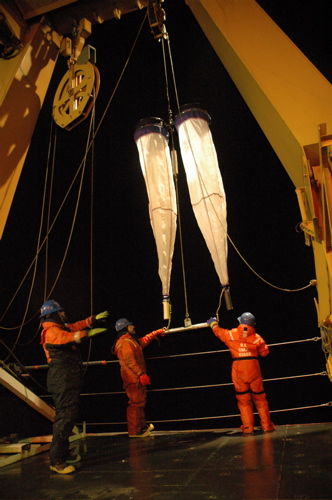 Can you see why these nets are called the Bongos? From the top they look like a set of drums. This net is used to collect a large quantity of plankton as well as record information about flow. How much plankton per how much water, in other words.
Can you see why these nets are called the Bongos? From the top they look like a set of drums. This net is used to collect a large quantity of plankton as well as record information about flow. How much plankton per how much water, in other words.
The Ring Net goes up and down through the water column slowly catching samples that are largely undamaged. The Bongos on the other hand, go up and down more quickly with finer mesh in tow. They catch more plankton that is unable to slip through the smaller holes. Quantity vs. quality. The flow meter attached to this instrument also gives the team a reading of how much water passed through the net so that they can calculate population density based on how much they collect. The Video Plankton Recorder (VPR) goes last, providing a peek at what these little guys are doing in their natural habitat rather than dished up in the cold room.
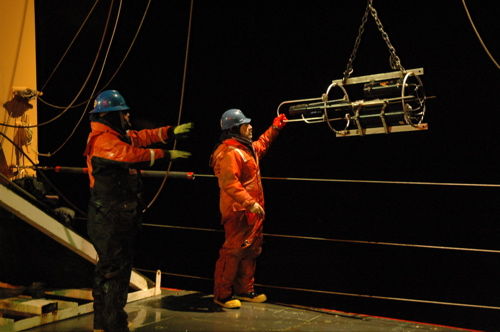 Phil Alatalo of Woods Hole Oceanographic Institute deploys the Video Plankton Recorder. Videos of the plankton in their natural habitat give a more complete picture of what life is like out there in the dark, chilly water.
Phil Alatalo of Woods Hole Oceanographic Institute deploys the Video Plankton Recorder. Videos of the plankton in their natural habitat give a more complete picture of what life is like out there in the dark, chilly water.
The Cold Room is where we are headed next. This is what the sample looks like in there...
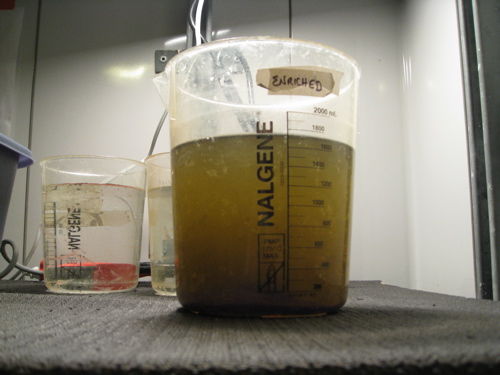 The sampled water looks like this when it reaches the cold room. While this might not look exciting to most people, this stuff is liquid gold to the zooplankton team!
The sampled water looks like this when it reaches the cold room. While this might not look exciting to most people, this stuff is liquid gold to the zooplankton team!
For hours critters are sorted according to who they are, grazing experiments are carried out and eggs are counted. The team members take turns working until their fingers go numb or they need a hot chocolate break. Take a look at one little guy that we could see under the scope below!
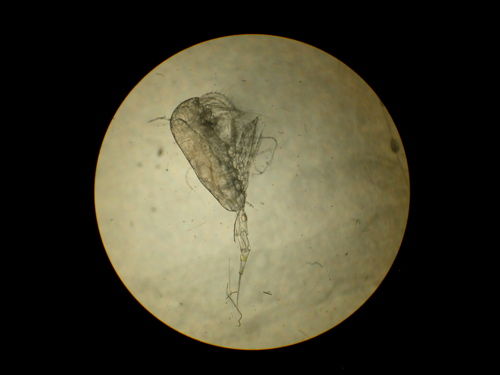 These guys bioluminesce when they are disturbed. This means that they glow in the dark. When we poured them into the bucket, it looked like fireflies in the summer!
These guys bioluminesce when they are disturbed. This means that they glow in the dark. When we poured them into the bucket, it looked like fireflies in the summer!
The bloom sure keeps things bustling around here so I'm off... stay tuned!

